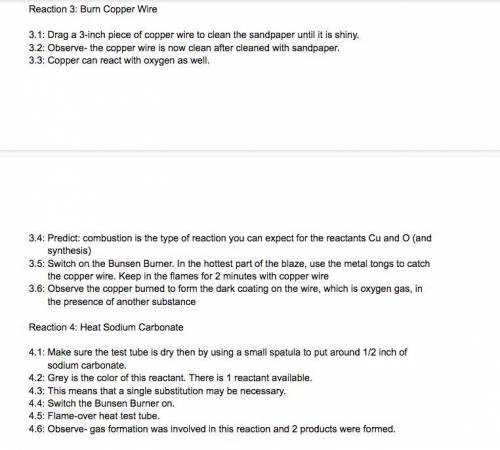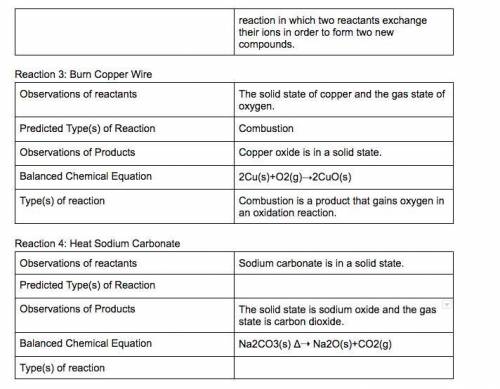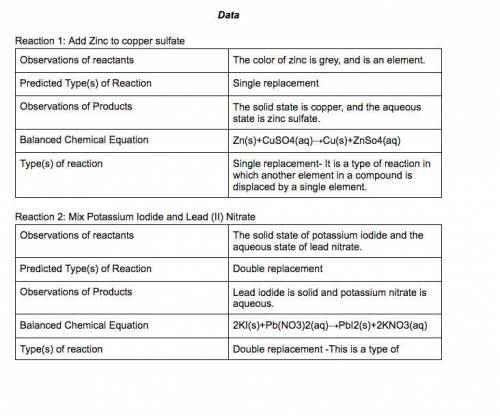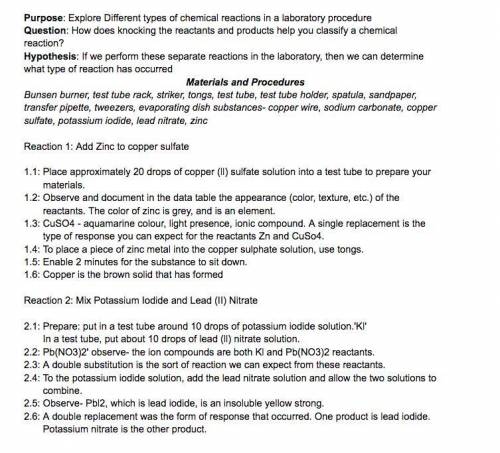Lab: Types of Chemical Reactions
Student Guide
This laboratory allows you to study various ki...

Lab: Types of Chemical Reactions
Student Guide
This laboratory allows you to study various kinds of chemical reactions, including some that result in precipitates.
Lesson Objectives
• Compare and contrast synthesis, single-displacement, and double-displacement reactions.
PREPARE
Approximate lesson time is 60 minutes.
Materials
• Lab Instructions: Lab_5.08_Instructions_modified_2020
• Lab Report: Lab_5.08_Report_modified_2020
• Lab Guidelines: Lab_Guidelines_modified
LEARN
Activity 1: Types of Chemical Reactions 1
Instructions
As you read through the lesson online, use the space below to take notes.
In this laboratory, you will study different kinds of chemical reactions.
Knowing the types of reactions helps you interpret your observations.
In a synthesis reaction, two reactants unite to form a third product.
In a single-displacement reaction, one ion of a reactant bonds with the second reactant.
In a double-displacement reaction, ions of both reactants change places.
Activity 2: Types of Chemical Reactions 1
Instructions
Procedure
1. Open the Chemical Reactions Virtual Lab.
2. Click View the Tutorial and complete the tutorial to learn how to conduct the lab.
3. Close the tutorial and click begin the Lab.
Part 1 Synthesis Reaction
4. Perform the procedure, placing the magnesium strip in the flame.
5. Record your reaction.
6. Research the chemical reaction of magnesium and oxygen gas. Write an equation for the chemical reaction
that accounts for the observed reaction in this part of the lab.
7. Answer the question: What is a synthesis reaction?
8. Answer the questions on Part 1 in the Lab Report.
Part 2 Single Displacement Reaction
9. Place 1 scoop of zinc in Vial A and add 10 drops of copper (II) sulfate. Observe the reaction.
10. Place ball of aluminum in Vial B and add 10 drops of copper (II) sulfate. Observe the reaction.
11. Place 1 scoop of zinc in Vial C and add 10 drops of silver nitrate. Observe the reaction.
12. Place copper wire in Vial D and add 10 drops of silver nitrate, wait 5 minutes. Observe the reaction.
13. Complete the ta

Answers: 1


Other questions on the subject: Chemistry

Chemistry, 22.06.2019 10:00, zionlopez543
Americium-241 undergoes fission to produce three neutrons per fission event. if a neutron-absorbing material is mixed in with this sample so that the rate of neutron production drops down to 1.8 neutrons per fission event, which will be effective at achieving a critical mass? check all that apply. remove a deflective shield surrounding the sample. remove absorbent material mixed in with the sample. compress the sample of americium-241.
Answers: 1

Chemistry, 22.06.2019 13:30, justinerodriguz2878
What are the major types of a chemical compound
Answers: 2

Chemistry, 22.06.2019 19:30, gracieisweird12
Use the periodic table to find the molar mass of each element. molar mass h = g/mol molar mass s = g/mol molar mass o = g/mol
Answers: 3

Chemistry, 23.06.2019 01:30, kenldykido2300
Adirect relationship can be represented by: a curve a pie chart
Answers: 2
You know the right answer?
Questions in other subjects:



Mathematics, 22.05.2021 04:00


Mathematics, 22.05.2021 04:00


Health, 22.05.2021 04:00


Mathematics, 22.05.2021 04:00








